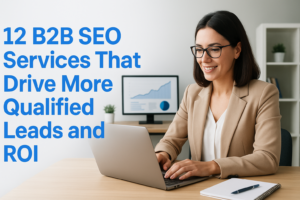

AI and Competitive Advantage: Leveling the Playing Field
Why AI for Competitive Advantage is No Longer Optional
AI for competitive advantage has shifted from a “nice-to-have” to a fundamental requirement for business survival. While some experts argue that AI’s increasing ubiquity will lead to industry homogenization, the reality is more nuanced. Here’s what businesses need to know:
Key Ways AI Creates Competitive Advantage:
- Strategic differentiation through proprietary data and specialized applications
- Accelerated innovation – reducing development time from years to months
- Improved customer experiences through hyper-personalization
- Operational efficiency gains of 30%+ in productivity
- New business models that weren’t possible before AI
The Critical Success Factors:
- Data strategy – leveraging unstructured data (70% of enterprise data)
- Digital core strength – robust infrastructure and platforms
- Continuous learning – upskilling workforce for AI collaboration
- Human-AI integration – combining creativity with AI capabilities
- Responsible AI practices – ensuring ethical, secure deployment
I’m Randy Bryan, founder of tekRESCUE and an AI expert who has spoken to over 1,000 business leaders about AI for competitive advantage and its transformative potential. Through my work helping businesses in Central Texas steer digital change, I’ve seen how strategic AI adoption separates industry leaders from those left behind.

Basic AI for competitive advantage vocab:
The Evolving Landscape of AI for Competitive Advantage
The business world has reached a pivotal moment. AI for competitive advantage has transformed from a distant possibility into today’s reality, fundamentally reshaping how companies operate and compete. The conversation has evolved beyond whether your business should adopt AI—the real question now is how strategically you’ll implement it.
Here’s what’s fascinating: while many fear that widespread AI adoption will make all businesses look the same, the opposite is actually happening. Companies that understand how to leverage AI strategically are pulling ahead, while those treating it as just another productivity tool are falling behind.
Companies that are building advantages across all six key areas have delivered a 10.7 percentage point total return to shareholder premium in 2023 compared to those that aren’t. This isn’t about having the latest AI gadgets—it’s about having a thoughtful, comprehensive AI strategy that touches every aspect of your business.
The secret lies in three critical areas: strategic application, unique data, and the invaluable human element. Let me show you how forward-thinking businesses are making this work.
Beyond Productivity: Crafting Unique AI-Driven Advantages

Most businesses start their AI journey focused on productivity gains, and that’s understandable. Who doesn’t want to automate routine tasks and free up their team for more valuable work? But here’s where it gets interesting: while 90% of AI use cases fall into productivity, improvement, personalization, and innovation, the latter three are where true differentiation happens.
The businesses winning with AI for competitive advantage aren’t just making their existing processes faster—they’re completely reimagining what’s possible. Take drug findy, for example. Traditionally, bringing a new drug to trial takes up to six years and costs over $400 million. Insilico Medicine turned this model upside down, developing the world’s first generative AI-designed drug in just 18 months for only $2.6 million.
Accelerated R&D and product development represents just one way AI is creating genuine competitive advantages. In the insurance industry, AI is revolutionizing underwriting workflows where 40% of time was previously spent on administrative tasks—representing an industry-wide efficiency loss of up to $160 billion over five years.
Hyper-personalization and customer experience offer another powerful avenue. Netflix didn’t just use AI to recommend movies—they reduced customer churn by several percentage points by creating deeply personalized experiences that competitors couldn’t match.
Some companies are taking an even more sophisticated approach by using AI as a “giant sensor” to monitor markets, competitors, and trends. One airline company systematized their innovation process this way, using AI to provide custom innovation recommendations based on real-time market intelligence.
Brand persona improvement through generative AI is creating another layer of differentiation. Companies are reimagining how they present themselves to the world, creating interactive, personalized experiences that are nearly impossible for competitors to replicate quickly.
But here’s the crucial insight: moving beyond basic productivity gains requires a fundamental shift in thinking. Instead of asking “How can AI make this task faster?” the winning question becomes “How can AI make this impossible for competitors to match?”
Specialized AI models are becoming the new battleground. While everyone has access to general-purpose language models, companies creating Small Language Models with proprietary data are building genuine moats. These specialized models can be deployed safely on internal infrastructure while delivering task-specific intelligence that generic models simply can’t match.
The most sophisticated organizations are building compound AI systems—intelligent frameworks that combine multiple models, databases, and software tools. These compound AI systems provide flexibility and customization that single-model approaches can’t deliver.
Reasoning and problem-solving capabilities represent the next frontier. The future belongs to AI systems that can perform nonlinear skills like abstraction and generalization, moving far beyond content generation into genuine strategic thinking.
This is exactly what our AI for Process Improvement services help businesses find—those transformative opportunities that create lasting competitive advantages rather than temporary productivity bumps.
The Foundation: Data, Digital Core, and Continuous Learning

Here’s something that might surprise you: while AI algorithms are becoming commoditized, unique, high-quality proprietary data remains a critical differentiator. It’s like having the same recipe as everyone else but access to ingredients nobody else can get.
Most companies are sitting on a goldmine they don’t even realize they have. Unstructured data accounts for around 70% of enterprise data on average, yet most companies (58%) primarily use only structured data. Think about all those customer service transcripts, email threads, meeting notes, and document repositories gathering digital dust while containing insights that could transform your business.
The concept of Data Learning Effects (DLEs) is particularly fascinating. As The AI First Company explains, DLEs create a counter-intuitive combination of learning effects, scale effects, and network effects. AI can automatically generate new insights from clients’ data, creating compounding advantages that get stronger over time.
But here’s the reality check: only 13% of executives are fully confident their organization has the right digital core capabilities. This creates a massive opportunity for businesses willing to invest in the foundation while their competitors struggle with outdated infrastructure.
A robust digital core isn’t just about having the latest technology—it’s about creating a flexible, scalable foundation that can evolve with your AI ambitions. The biggest concerns executives express tell the whole story: hardware infrastructure worries 48% of leaders, while software platforms and tools concern 35%, data management and governance affect 35%, and cloud capabilities trouble 26%.
This is why our Digital Change: Leveraging Managed IT Services approach focuses on building this foundation correctly from the start. You can’t build a skyscraper on a shaky foundation, and you can’t build AI for competitive advantage on weak digital infrastructure.
Continuous learning and talent development represent the human side of this equation. Here’s a sobering statistic: only 26% of executives report confidence in their workforce and skills for three years out, and few (25%) have a talent roadmap. The rate of learning within an organization directly impacts its ability to leverage AI effectively.
This isn’t about replacing people with machines—it’s about empowering your team to work alongside AI in ways that amplify their capabilities. Upskilling and reskilling the workforce to interact with and manage AI systems is essential for long-term differentiation.
Our AI for Business Analytics services include comprehensive training components because we’ve learned that the most sophisticated AI implementation fails without a team that understands how to leverage these new capabilities effectively.
The Human Element: Integrating Creativity and Expertise
The most successful AI implementations I’ve seen don’t replace human judgment—they amplify it. “Humans as the loop” isn’t just a catchy phrase; it’s a fundamental principle that separates thriving businesses from those struggling with AI adoption.
AI models don’t operate in isolation. The most effective AI systems integrate human judgment and expertise, especially for complex tasks where full automation isn’t feasible. This means designing workflows where AI handles large-scale data processing and routine tasks, while humans provide critical analysis, decision-making, and creative input.
Consider how one bank transformed their customer service approach. They used AI to improve decision speed and consistency, reducing waiting times and detecting three times more potential frauds. But human oversight remained crucial for complex cases and relationship management. The AI didn’t replace the human touch—it made it more powerful and strategic.
When AI becomes ubiquitous, the competitive advantage shifts to cultivating employee creativity and unique application of the technology. This requires a fundamental shift in investment priorities—from purely technology procurement to programs that foster creative problem-solving in tandem with AI tools.
Seamless user experience and trust calibration are absolutely critical. AI systems must be designed for seamless integration into user workflows, optimizing for both human strengths and AI efficiency. Calibrating user trust is vital—flagging uncertain AI outputs for human review can prevent significant errors and build confidence in the system.
The same bank uses AI for fraud detection with proper trust calibration, flagging uncertain transactions for human review. Without this calibration, a compromised account could result in potential losses of $500,000. With it, they catch problems early while maintaining customer trust.
AI transforms jobs rather than eliminating them. Companies need to develop internal training programs that boost creative problem-solving and ensure employees have both major and minor AI skills, regardless of their role. The goal isn’t to create a workforce of AI experts—it’s to create a workforce that can think creatively about AI applications.
Our Smart IT Strategies: Why a vCIO is Essential for Businesses approach includes AI readiness assessments because we’ve learned that organizational preparation is just as important as technological capability.
The businesses winning with AI for competitive advantage understand that the technology is just the beginning. The real magic happens when creative, skilled humans use AI to solve problems and create value in ways that seemed impossible just a few years ago.
Navigating the Future: Challenges, Ethics, and Business Model Change

As businesses rush to accept AI for competitive advantage, they face a complex web of challenges that can make or break their success. The path forward isn’t just about technology—it’s about navigating ethical minefields, rebuilding business models, and creating sustainable frameworks for growth.
What are the key challenges and ethical considerations businesses must address when adopting AI to ensure it truly serves as a competitive advantage?
The reality is sobering: only 14% of executives say they have fully operationalized responsible AI across their organization. This gap between ambition and execution creates real risks that can undermine competitive advantage rather than improve it.
Ethical AI and trust form the foundation of sustainable competitive advantage. When OpenAI developed GPT-4, they made it 82% less likely to respond to improper requests compared to its predecessor. This wasn’t just about being responsible—it was about building trust that enables broader adoption and competitive differentiation.
Data privacy and security concerns intensify as AI systems require vast amounts of information to function effectively. The extensive data collection needed for AI raises significant privacy concerns that go beyond traditional cybersecurity. Companies must implement robust measures and adhere to data protection regulations to maintain customer trust. This is where our Managing the Cybersecurity Vulnerabilities of Artificial Intelligence services become critical for businesses.
Integration complexity presents another major hurdle. Many companies find that their existing legacy systems simply can’t support sophisticated AI applications. The digital core gaps we discussed earlier become painfully apparent during implementation. This challenge is precisely why our comprehensive approach to The Challenges and Opportunities of Business Technology proves invaluable for organizations.
Talent and skill gaps remain the most persistent challenge. The lack of confidence in workforce skills and talent roadmaps creates a bottleneck that prevents effective AI adoption. Companies need structured approaches to develop AI literacy across their organizations, not just in their IT departments.
How does AI adoption impact traditional business models and what new approaches are required to capitalize on AI’s potential?
The change runs deeper than most executives realize. AI doesn’t just improve existing processes—it fundamentally changes how value is created and captured. When AI makes it vastly easier and cheaper to create or improve products and services, businesses must rethink their entire value proposition.
Rethinking business models becomes essential as AI disrupts traditional approaches. Industries that previously required significant human labor and creativity find themselves vulnerable to commoditization. The companies that thrive are those that use AI to create entirely new forms of value rather than simply automating existing processes.
Transformative impact across functions is already happening at scale. Organizations plan to make fundamental changes using generative AI over the next three years, with IT departments leading at 63%, followed by marketing at 54%, and finance at 41%. This represents a shift from siloed applications to enterprise-wide change.
Ecosystem partnerships are becoming increasingly important as companies compete to be desirable partners. This involves embedding AI capabilities into services, connecting customers to niche AI-enabled products, and offering datasets for training. The most successful companies are those that think beyond their traditional boundaries.
AI-First mindset represents the ultimate change. Moving towards an “AI-First” company model means AI isn’t just a tool but a core strategic driver. This enables new forms of competitive advantage like Data Learning Effects (DLEs) that compound rapidly, creating sustainable moats around business operations.

The numbers tell a compelling story. According to Forrester, businesses leveraging AI tools strategically have seen a 6% increase in net revenue and a 20% reduction in operating costs. Perhaps more importantly, they’ve achieved a 25% acceleration in new-hire onboarding and 24% of businesses experienced a 16% to 20% reduction in time to market for new products.
These results demonstrate the tangible benefits of strategic AI adoption, but they only apply to companies that approach implementation systematically. The difference between success and failure often comes down to having the right foundation, the right partnerships, and the right mindset about what AI can and cannot do.
The future belongs to organizations that can steer these challenges while maintaining their ethical compass and human-centered approach. It’s not about replacing human judgment—it’s about augmenting it in ways that create sustainable competitive advantage.
Conclusion: Your Strategic Path Forward
The journey to harness AI for competitive advantage is complex, requiring a blend of technological investment, strategic foresight, and a deep commitment to human-AI collaboration. While the initial wave of AI adoption may lead to some homogenization, the true differentiators will be those who master proprietary data, build robust digital foundations, foster continuous learning, and most importantly, integrate human creativity and judgment with AI capabilities.
This strategic approach ensures that AI serves as a powerful engine for unique, defensible, and sustainable competitive advantage. The companies that succeed will be those that view AI not as a replacement for human capabilities, but as an amplifier of human potential.
Through our work with businesses across Central Texas and the DFW area, we’ve witnessed this change firsthand. The businesses that thrive are those that take a holistic approach to AI adoption – one that encompasses technology, people, processes, and culture. They understand that AI for competitive advantage isn’t just about having the latest tools; it’s about creating systems that learn, adapt, and evolve with their business needs.
The path forward requires courage to move beyond basic productivity gains and accept the transformative potential of AI. It means investing in your people, your data strategy, and your digital infrastructure simultaneously. Most importantly, it means recognizing that the human element remains irreplaceable in creating truly differentiated value.
The time for incremental AI adoption is over. The businesses that will dominate their industries in the coming years are those that act decisively now to build comprehensive AI strategies that leverage all six key areas of competitive advantage.
To explore how your business can strategically leverage AI for competitive advantage and transform your operations, contact tekRESCUE for expert Strategic AI Consulting. We serve businesses in San Marcos, TX, Kyle, TX, Dallas, TX, San Antonio, TX, Central Texas, and the DFW area.
Ready to gain your competitive edge? Visit mytekrescue.com to schedule your AI strategy consultation.
Table of Contents









